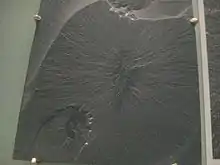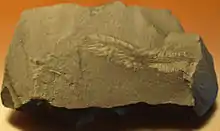Canadia (annelid)
Canadia (meaning of Canada or after Canada) is a genus of extinct annelid worm present in Burgess Shale type Konservat-Lagerstätte. It is found in strata dating back to the Delamaran stage of the Middle Cambrian around 505 million years ago, during the time of the Cambrian explosion. It was about 3 centimeters (1.2 inches) in length. Charles Doolittle Walcott named Canadia in 1911 after Canada, the country from which its remains have been found. 28 specimens of Canadia (annelid) are known from the Greater Phyllopod bed, where they comprise 0.05% of the community.[1]
| Canadia | |
|---|---|
 | |
 | |
| Canadia spinnosa | |
| Scientific classification | |
| Kingdom: | Animalia |
| Phylum: | Annelida |
| Class: | Polychaeta |
| Genus: | †Canadia Walcott, 1911 |
| Species: | †C. spinosa |
| Binomial name | |
| †Canadia spinosa Walcott, 1911 | |
Description
Canadia grew to 2-8 inches (5-20 centimeters) long.
The animal's most notable feature is the many notosetae (rigid setae extending from dorsal branches of notopodia) along the back of the animal that are characteristic of polychaete worms. It has been suggested that these notosetae may have been iridescent when the organism was alive due to evidence of diffraction gratings found on the surface of some fossils.[2] (See also: Structural coloration and the images at Aphrodita.)
Tentacles extended from the prostomium and may have served as sensory organs. The gut of Canadia was straight and had the ability to extend out of the body in the form of a proboscis, suggesting that the animal was carnivorous. This is further evidenced by the lack of sediments found in the gut that would be present in a benthic detritivore.[3] Canadia is thought to have swum above the seafloor as a primary means of locomotion by beating its numerous notosetae.[4]
It would also have had the ability to creep along the seafloor using the ventral counterpart of the notopodia, which are termed neuropodia (in reference to the proximity to the paired, ventral nerve cords characteristic of annelids).
Classification
There has been some debate as to the placement of Canadia within the Annelida phylum. Although it is commonly accepted to be within Annelida, it is uncertain how it relates to modern annelids. Most paleontologists agree that it belongs to the class Polychaeta due in part to the presence of Parapodium. It has been proposed to be a member of the order Phyllodocida along with Wiwaxia, another organism from the Burgess Shale. Both were placed in a new superfamily called Canadiacea, and were thought to be of closer relationship to each other than to modern annelids.[5] However, Wiwaxia is no longer believed to have been an annelid and there is currently dispute as to whether or not Canadia should be classified as belonging to anything more derived than Polychaeta.[6]
References
- Parker, Steve. Dinosaurus: the complete guide to dinosaurs. Firefly Books Inc, 2003. Pg. 37
- Caron, Jean-Bernard; Jackson, Donald A. (October 2006). "Taphonomy of the Greater Phyllopod Bed community, Burgess Shale". PALAIOS. 21 (5): 451–65. doi:10.2110/palo.2003.P05-070R. JSTOR 20173022.
- Parker, A. R. 1998. Colour in Burgess Shale animals and the effects of light on evolution in the Cambrian. Proceedings of the Royal Society of London Series B 265:967-972.
- http://paleobiology.si.edu/burgess/canadia.html
- Conway Morris, S. (1979). "Middle Cambrian Polychaetes from the Burgess Shale of British Columbia". Philosophical Transactions of the Royal Society of London. Series B, Biological Sciences. 285 (1007): 227–274. Bibcode:1979RSPTB.285..227M. doi:10.1098/rstb.1979.0006. JSTOR 2418139.
- Butterfield, N.J., 1990b. A reassessment of the enigmatic Burgess Shale fossil Wiwaxia corrugata (Matthew) and its relationship to the polychaete Canadia spinosa Walcott. Paleobiology, v.16, no.3, p.287-303
- Eibye-Jacobsen, D. (September 2004). "A reevaluation of Wiwaxia and the polychaetes of the Burgess Shale. Lethaia, v.37, no.3, p. 317-335
External links
- "Canadia spinosa". Burgess Shale Fossil Gallery. Virtual Museum of Canada. 2011. (Burgess Shale species 33)